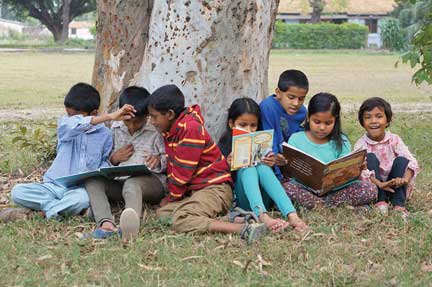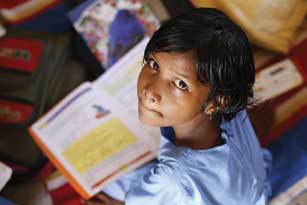Jane Sahi
The film, The Boy Who Harnessed the Wind (2019) tells the true story of a 13-year-old boy from Malawi who dropped out of school because his family could not afford the fees. Secretly, he uses the library and finds the book that he needs. Gradually putting together the information he gleaned from the book, Using Energy along with his own ingenuity and the support of his desperate family, he was able to help his village in a time of famine by constructing a makeshift windmill. Imagine a situation where a young teenager is so impassioned to pursue an interest that he breaks all rules and risks punishment to get into a library! This is a remarkable story from many points of view but not least that the library was the catalyst to make a young boy’s literacy so transformative.

This story highlights what literacy might mean for anyone and everyone beyond the mechanics of mastering speed, accuracy and neatness in reading and writing. Assessment of children’s reading levels is often done when children are just beginning to grasp the complexities of decoding. However, a more revealing appreciation of children’s reading competencies would be to look at older children’s voluntary engagement with books and to note the ways children read to make connections, find comfort and joy, seek information and knowledge about themselves and others and to find the confidence to navigate even difficult texts when there is a sense of purpose.
In the classroom, children’s reading is often confined to what is in a textbook. The teacher usually decides what is to be read and when and what should be the follow-up. There are exceptions and I well remember a history teacher who used to stagger into the classroom loaded down with texts including cartoons, poems and diary extracts, maps and pictures. I think he might have had a dual purpose in mind – firstly to throw light on a topic from multiple perspectives, but secondly to whet our appetite to explore the possibilities of reading widely and deeply. This was a way of bringing the library into the classroom!
When children realize that reading in itself is not the end goal but an entry point into other worlds then the library can become an inviting and exciting place. A college lecturer from Mysore remembering her childhood wrote about a daily race with her sisters to reach the library first during the summer holidays and then her delight once there, “With every book I borrowed from the library, I was venturing further into another world, a world where I was in charge, where I could live life my way.”* The library should be a space where children can be encouraged to explore unfamiliar subjects and authors, but also where they should have the liberty to choose what they want to read, how they want to read and who they want to read with.

The library can play a key role in bringing the child’s experiences of home, school and community together but at the same time the exposure to a rich resource of accumulated thought and knowledge expands immeasurably a child’s world. A librarian once recalled how as an 8-year-old, she chanced upon a book in a library that informed her that the light in the paddy field was phosphorous and not a ghost as she had assumed; from that time, strengthened by her new found knowledge, she could go out into the night without fear.
The library can be a meeting place where people not only interact around books but with each other at all ages and levels of competence and where children are expected, and therefore supported, to think, imagine, interpret and learn and grow through a lifelong journey of becoming readers and writers within a community.
Emergent literacy
Becoming part of a community of readers can begin when children are very young. Long before going to school and receiving any formal instruction in literacy young children begin to show what has been called “natural reading and writing behaviours”. These might include the way a child handles books, uses visual markings to represent the spoken word, draws or acts out the motions of reading. The library has the potential to model a kind of apprenticeship or “guided participation” in literacy.
It is being increasingly recognized that a library can welcome even the youngest children so that they have a chance to be a part of the library community. Visiting a library with a caregiver or siblings can give a child an opportunity to observe readers of all kinds in action and explore a space where books are centrestage; young children can participate in simple literacy events such as ‘read alouds’ or the re-telling of a story through puppet shows. Browsing through picture books can be the beginning of developing a discerning eye and a critical voice and discovering their own and others’ connections to all kinds of texts. Such positive experiences also contribute to children telling their own stories and at some point drawing or writing them and realizing that they too can be authors.

In the pre-primary classroom, a mini-library or book corner can be set up where children have the freedom to browse and respond to books with each other at their own pace and in their own way but at the same time learning that books need to be cared for. The same books can be used to make print come alive for children as the teacher or library educator can read the book or ask open-ended questions about the text. Children can recite or sing the poems on the page or re-tell the story by joining in with actions and filling in a repetitive chorus that is often characteristic of the best books for young ‘readers’. These are early experiences of taking an active part within a culture of literacy.
The critical shift to independent and voluntary reading
While the close and sensitive reading of a given text in class can be an enriching experience, children need to read beyond the context of a lesson and a prescribed text. Typically between the ages of six to eight years children begin to read independently and this marks a turning point as to whether children will continue to be adventurous readers or whether they will be limited to what they have to read to meet the demands of school work. Will they become confident, eager readers who have grasped why it is worth the effort to make sense of print or will they just grapple with the bare bones of literacy necessary to function on the margins of a print dominated society? It is at this juncture that it is so crucial for children to enjoy reading on their own terms and to be in a position where they can make choices. This can be made possible by access to a library with a rich collection of books in all genres and different languages that reflect a diverse and multicultural society.
Literacy as a continuum of learning
As children grow older, the school or community library can offer a space for children to study and to pursue their particular interests whether it is the construction of a windmill, the writings of a favourite author or the different sides of an argument or issue. When there is an authentic context to deepen enquiry about something then practice in accessing reference books and honing in on the relevant content in books, magazines and newspapers and other media become life skills and not a tedious task in a vacuum. The library educator can be an invaluable support and collaborator as children navigate their way through a maze of resources and inevitably meet doubts and further questions. In the process students learn about finding and filtering what is relevant to their question and at the same time opens up possibilities for further investigation.
The larger picture of literacy is a text’s connection to children’s social and emotional worlds; it means in Paulo Freire’s words to both “read and write the world”. To become fully literate, children need to learn to critique texts by sharing meanings and interpretations, sometimes to re-write them in their own words or relate an untold story or ask the questions that matter to them. If children feel comfortable and curious in the library then they are free to browse or delve into new ideas, unfamiliar authors and fresh perspectives on challenging issues. An inviting and vibrant library can enable children to grow through literacy in a space designed for work and play, delight and absorption; here children can follow and share their interests be it in poetry, engineering or natural history of the local environment. Literacy, then becomes a meaningful part of life.
*Dr Padma Baliga
The author has taught both adults and children over many years, In the last five years she has been part of a team that teaches a Library Educators’ Course at Bookworm in Goa. She has also been involved in a small learners’ centre that works with children in local government primary schools particularly through classroom libraries and looking at nature through observation, stories and art work. She can be reached at janehelensahi@gmail.com.
